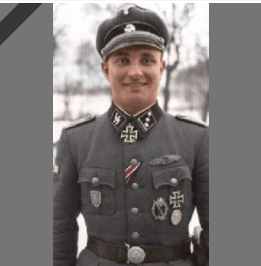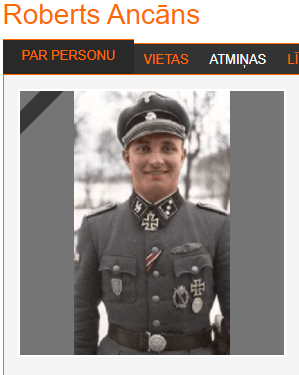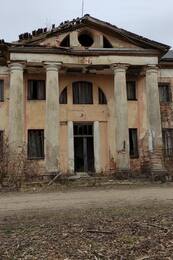Pilsblīdenės mūšis Roberto Ancano atsiminimuose
Robertas Ancansas (1919 m. lapkričio 11 d. – 1982 m. sausio 1 d.) buvo Latvijos legiono karininkas, Geležinio kryžiaus riterio kryžiaus ordino savininkas, dalyvavęs Pilsbidenės mūšiuose 1945 m. kovo 16 ir 17 d. Šeštasis Kuršo mūšis jau tęsiasi ketvirtą dieną. Anzānsas tarnavo Pilsbidenės apylinkėse, todėl gerai pažinojo šią vietovę. Anzano divizijos kryptį vėl nukreipia dar vienas fronto lūžis – 8 km gylio Raudonosios armijos įsiveržimas. Šiuose mūšiuose Anzánas sužeistas.
„Kovo 16-17 d. naktį mano dalinį Lestenėje pakeitė vokiečiai. Vėl keliaujame. Mūsų divizija atlieka „gaisrininkų“ vaidmenį. Lyja. Švintant, esame Jaunpilyje. Tuoj pat bolševikai taip pat pradeda aviacijos antskrydžius, kelionę galime tęsti tik po geros valandos. Lietus rimsta ir pamažu virsta sniegu. Vyrai eina iš paskos vežimams, sušalę, bet nebėra ko tiek bijoti rusų aviacijos antskrydžių. Taigi tęsiame kelionę link Zebrės ežero.“
Prie Zebrės ežero ir Saldaus krašte nepaliaujamai aidėjo patrankų šūviai. Šeštasis Kuršo mūšis tęsiasi ketvirtą dieną. Vakare pasiekiame Š. dvarą, kur skubiai įsikūrėme stovyklą. Iki ryto turime pakeisti nugalėtus vokiečių dalinius.
Tačiau automobiliai dar neatėjo ryto ir mes turime važiuoti į Pilsblīdenį, kur yra 8 km gylio invazija. Oras išsigiedrijęs, šviečia mėnulis ir pradeda stingti šaltis. Iš pradžių automobilis dažnai sustoja, nes įklimpstame purve, o ratai pasidengia storu Kuršo molio sluoksniu. Tačiau netrukus šaltis ištirpdo purvą ir mes išlipame prie Skrundos namo. Vyrai nemiegojo dvi naktis, buvo alkani ir dabar visi užmigo kaip mirę.
Kartu su pulko vadu einame į vokiečių divizijos štabą gauti mūšio įsakymų. Mus tuoj pat priima ir nustemba, generolas Šulcas kreipiasi į mus latvių kalba, nes jis tarnavo Latvijos armijoje ir vadovavo artilerijos pulkui. Mūsų užduotis – užimti Pilsblīdenės pilį ir aukštumas Salduso link. Padėtis fronte neaiški.
Einame į naująjį pulko vadovavimo postą – Kuiļi mājas ir, pasilenkę virš stalo, tyrinėjame puolimo kryptį. Esu geras vietovės žinovas, nes 1940 m., kai 1-asis Liepojos pėstininkų pulkas buvo dislokuotas Kurše, tarnavau tiesiai Pilsblīdenės pilyje ir dalyvavau daugelyje kovinių mokymų jos apylinkėse.
Turėjo prasidėti artilerijos apšaudymas, bet nieko. Paskambinau pulko vadui. Jis pažadėjo, kad prasidės, bet vokiečių artilerija nebeveikė tinkamai. Puolimas buvo atidėtas valandai. Vyrai buvo išsekę. Net pakeisti postus buvo sunku. Virš mūsų pradėjo šaudyti bolševikų artilerija ir granatsvaidžiai. Galiausiai, 17 val., mūsų pabūklai taip pat pradėjo šiek tiek šaudyti ir 17:30 val. pradėjome puolimą. Bolševikai jau kelias valandas laukė mūsų atakos. Greitai numalšinome priešakines grupes ir pasiekėme pilį, bet toliau negalėjome pasiekti, nes vienu metu į mus prasidėjo bolševikų automatinių ginklų apšaudymas, kuris buvo toks stiprus, kad net negalėjome pakelti galvų. Jie šaudė ne tik iš visų namų kampų, bet ir iš langų bei palėpių. Pilies kieme ir apylinkėse girdėjosi stiprus tankų riaumojimas.
Keli jų dalyvavo mūšyje, bet mūsų tankai į parką nepateko. Priešo tankas buvo nepasiekiamas tankų kumščiams. Būtų kvaila tęsti ataką, kodėl turėtume bandyti pulti iš kairės, aplenkdami tvenkinį.
Šis manevras taip pat nepavyksta, ir įmonė turi trauktis su nuostoliais per sudegusį parką.
Po nesėkmingo puolimo bolševikai ima imtis iniciatyvos ir puola mūsų kuopą aukštumoje iš abiejų flangų. Vieną – nuo pilies, kitą – Kaulačių keliu iš miško. Prasidėjus temai, esame priversti atitraukti kuopą ir pereiti į gynybą palei geležinkelio linijos pakraštį. Nuovargis neįveikiamas. Prasideda trečia bemiegė naktis. Su dideliais sunkumais mums pavyksta organizuoti postų pasikeitimą.
Staiga rūmuose ir už jų prasideda didžiulis priešo judėjimas. Įsakymai, šūksniai, prožektoriai, variklių riaumojimas. Sargybinis tai stebi jau mažiausiai pusvalandį. Po kurio laiko bolševikai, stipriai remiami tankų, iš tikrųjų pradeda naktinį puolimą, oras virpa. Visi išskubame iš stoties į pozicijas ant geležinkelio pylimo. Jau šiek tiek po pirmos valandos. Raketos krenta parašiutais, lėtai sklandydamos. Penki „Tigrai“ išsirikiuoja į mūšį. Mano funkistai praneša vadui apie situaciją, bet jiems nepavyksta iškviesti artilerijos. Galiausiai nutinka kažkas neįprasto.
Mūsų siųstuvui pavyko pagauti tą pačią bangą kaip ir bolševikų, ir dabar mes pradedame vaidinti rusų tankų majoro Arturovo vaidmenį.
Šio Artūrovo padedami, nukreipėme artėjančią ataką ten, kur šioje geležinkelio pusėje tyvuliavo nedidelis ežerėlis su biriu ledo sluoksniu. Bolševikų tankas degė liepsnomis, šaudė iš kulkosvaidžių, sproginėjo granatos.
Kovos taip pat staiga, kaip ir prasidėjo, taip ir baigėsi. Vyrai eina į taiką, tai ilgai netruks. Rusai nori atkeršyti už apgaulę.
Šviesa pradeda blėsti, ir dabar pastebime, kad bolševikai puola su visu tankų batalionu ir keliomis pėstininkų kuopomis. Taip pat pavyksta išsikviesti savo artileriją ir, gerai pažindamas vietovę, noriu išbandyti laimę „Tigruose“. Viskas jau suderinta su tankų karininku.
Mūsų tikslas – užimti tylią poziciją su 3 tankais po priedanga kairėje, leisti bolševikams pasiekti geležinkelio liniją ir tada juos sunaikinti iššokanti ugnimi.
Jau ore, ir mūšis įsibėgėjo. Stotis – visų priešo sunkiųjų ir automatinių ginklų taikinys. Ką tik su tanko leitenantu apžiūrėjome vietovę, kai į tanką pataikė granata, o skeveldros gausiai susikaupė mano dešinėje rankoje ir...
kojoje.
Puolimas sustabdytas, bet mano jėgos senka.
Skubiai prašau stoties gynėjų atsiųsti bent 10 tankų pastiprinimą, bet jiems dar neatvykus, stotis patenka į jų rankas per trečiąjį rusų puolimą po pietų.
Greitoji pagalba lėtai mane veža į galą. Pakeliui sutinku naujus dalinius ir tankus, o tai suteikia man tikėjimo, kad viskas vėl bus gerai.
Sėdėdama šalia vairuotojo, veidrodėlyje pastebiu, kokia atrodau pavargusi, barzdodama, suodinama, kruvina ir išblyškusi.
10 val. esu Vanėje, bet kitą dieną atvyksta naujų sužeistųjų ir esu perkeliamas į Stendi, o paskui į Talsus. Ten žaizdos lėtai siuvamos, ir iš 13 skylių rankoje tik 7 yra atviros.
Artėja Velykos, o naujoji Talsų mokykla, kuri dabar yra karo ligoninė, sulaukia daug lankytojų ir delegacijų. Mūsų kariai turi ne mažiau dovanų nei anksčiau Rygoje, Kuržemė tiki savo kovotojais.
Roberts Ancāns (timenote.info)
Susijusi laiko juosta
Susijusios vietos
Pilsbidenės dvaras
Dvaro rūmai buvo pastatyti klasicistinio stiliaus XIX a. 3-ajame dešimtmetyje. Po žemės reformos dvaro kompleksas buvo nuomojamas privatiems asmenims, tačiau nuo 1932 m. atiteko Liaudies gerovės ministerijai.
6. Per įnirtingus Didžiojo Kuršo mūšio mūšius jis buvo naudojamas ir kaip atramos postas, ir kaip ligoninė.
1945 m. kovo 17 d. prasidėjo paskutinis Raudonosios armijos bandymas pulti Kuršą. Vokiečių 24-osios pėstininkų divizijos daliniai gynėsi Pilsblīdenės dvaro komplekso apylinkėse. 1945 m. kovo 18 dvarą iš pietų puolė 43-iosios gvardijos Latvijos šaulių divizijos 121-asis šaulių pulkas, tačiau nesėkmingai. Iš vakarų puolė 7-osios Estijos šaulių divizijos 300-ojo šaulių pulko 1-asis batalionas, o dienos pabaigoje 3-iojo gvardijos mechanizuotojo korpuso 35-oji tankų brigada Blīdenės-Remtės kelyje prisijungė prie 249-osios Estijos šaulių divizijos 917-ojo šaulių pulko 1-ojo bataliono.
Kovo 19-osios naktį 19-osios Latvijos SS Grenadierių divizijos 43-iasis Grenadierių pulkas atvyko į Blīdenės stoties apylinkes ir kontratakavo, siekdamas atsiimti Pilsblīdenės dvaro gyvenamąjį pastatą. Tačiau po naktinės tankų atakos stotyje įsitvirtino Raudonosios armijos estų ir latvių daliniai.
1959 m. pilyje kilo gaisras. Nuo 1961 iki 1986 m. gyvenamajame pastate veikė senelių namai. 1986 m. pilį vėl sunaikino gaisras. Nuo to laiko pilis stovi tuščia ir apgriuvusi.
Dvaro rūmus supa 24 hektarų parkas, kuris dabar apaugęs. Parke yra apie 37 nevietinių medžių ir krūmų rūšių plantacijos, jis yra saugomas valstybės. Parkas neprižiūrimas, o aplinka apaugusi.







